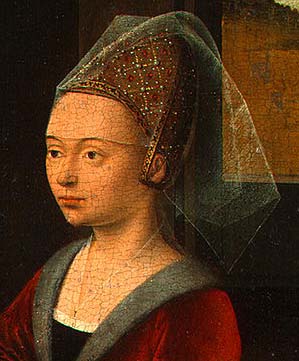I've been doing some research on fashionable headwear for ladies in the 15th Century. Keeping hair hygienic during this period of history was next to impossible, so the simplest solution was to cover it altogether. It was around this time that a greater variety of headdresses were seen, such as the caul - a netted ovaloid form on either side of the head. There were also the padded roll headdresses - tubes of fabric manipulated and curved into various shapes. Perhaps most famous is the henin, which forms the basis of the iconic 'princess hat'.
 Hugo van der Goes' "Portinari triptych" (detail of Mary Portinary, right wing) 1479
Hugo van der Goes' "Portinari triptych" (detail of Mary Portinary, right wing) 1479
This is an example of the henin, a cone shaped hat usually with a veil draped from the top.
 Petrus Christus, c.1450 - Detail from Portrait of a Female Donor
Petrus Christus, c.1450 - Detail from Portrait of a Female DonorThere was also a cut-off version called the truncated henin, a sort of decorated fez with two wire antennae projecting off the front to the back of the head which supported the veil.
 A detail from King René's tournament book.
A detail from King René's tournament book.
This method of supporting a veil became increasingly dramatic leading to the butterfly henin, the antennae come from the top and are angled down, creating a scaffolding for multiple layers of veiling. The reticulated design (meaning diamond pattern) on the cone itself was very popular throughout all styles of headdresses.
There are no surviving examples of headdresses from this period so it cannot be said for sure how they made them or what they made them from. However it is quite likely that they used wires to create the antennae. As for the materials used in creating the rigid cones they may have used a form of stiffened felt or possibly bundles of reed. Certainly the Tudors are known to have used reed to bone corsets so it is not unreasonable to suggest this.

I think the henin in all its forms is inspiring and I have been inspired to make one. I have drawn up a basic pattern for a truncated henin and next I will make it up in fabric to test it out.






















